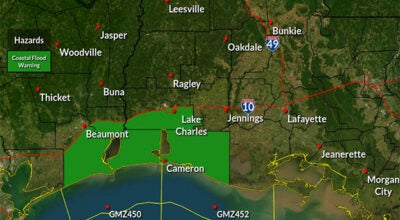County meets with state for coastal erosion plan
Published 2:30 pm Saturday, November 26, 2016
A coastline that is resilient in response to coastal hazards is one that maintains a strong ecological foundation, according to the Preview of the Texas General Land Office’s Texas Coastal Resiliency Master Plan.
Resiliency, likewise, is defined as the ability of a given system to absorb natural and/or anthropogenic disturbances, and retain or quickly return to a desired state.
Representatives with Jefferson County met with GLO staff on Nov. 15 at The Event Centre in Beaumont to discuss coastal resiliency.
Representatives with GLO gave a PowerPoint presentation in regard to the master plan.
Don Rao, county engineer, said it was an informative type of meeting so everybody will know what needs to be done for coastal counties, particularly Jefferson and Orange Counties.
A portion of the master plan involves enhancing the Port Arthur Levee, building a levee for Orange County and building more levees for Jefferson County.
The U.S. Army Corps of Engineers, likewise, is working on this project.
“Everybody wants to get their ducks in a row and be on the same page if there should be some more BP (British Petroleum/ Deepwater Horizon settlement money) comes in,” Rao said.
He added that the money could be used for siphon work. Work being done at McFaddin Beach and the J.D. Murphree Wildlife Management Area is from a grant through the National Fish and Wildlife Foundation.
Coastal Texas Protection and Restoration Feasibility Study
- Goals:
- Develop a comprehensive plan for the Texas coast for coastal storm risk management and ecosystem restoration.
- A study to determine the feasibility of constructing projects for hurricane and storm flood damage reduction and ecosystem restoration.
- Outcome:
- In 2021, the feasibility study report and environmental impact study will be presented to Corps HQ.
- Corps HQ will prepare a chief’s report to congress recommending projects for authorization and funding.
- Timeline: November 2015 to 2021.
Sabine Pass to Galveston Bay Study
- Goals:
- Conduct a feasibility study to evaluate potential upgrades to existing coastal reform risk management systems in Brazoria and Jefferson Counties.
- Construction of a proposed coastal storm risk management system for Orange County.
- Outcome:
– The feasibility analyses will determine if there is a federal interest in funding potential coastal storm risk management projects in the identified regions.
- Timeline: To be completed in 2017.
Texas Coastal Infrastructure Study
- Goal:
– To conduct an assessment of critical infrastructure within 22 coastal counties to identify existing projects and recommend new projects to mitigate potential damage to vulnerable infrastructure.
- Outcome:
– The study identified 2,200 critical infrastructure assets within the study area that are most vulnerable to future storm impacts.
– The compiled project list was shared with coastal communities to help inform their decisions about future infrastructure planning and funding.
- Timeline: This study was completed in 2016.
Gulf Coast Community Protection and Recovery District Storm Surge Suppression Study
- Goal:
– Conduct a phased storm surge suppression study of the upper six coastal counties: Brazoria, Chambers, Galveston, Harris, Jefferson and Orange.
- Outcome:
– A report with three recommended systems of flood damage reduction and storm surge suppression measures based on modeling and cost-benefit analysis of potential storm protection projects.
- Timeline: Phases 1-3 are complete. Phase 4 will be complete in 2016 – December 2017.
Texas Coastal Infrastructure Study
- Goal:
– To conduct an assessment of critical infrastructure within 22 coastal counties to identify existing projects and recommend new projects to mitigate potential damage to vulnerable infrastructure.
- Outcome:
– The study identified 2,200 critical infrastructure assets within the study area that are most vulnerable to future storm impacts.
– The compiled project list was shared with coastal communities to help inform their decisions about future infrastructure planning and funding.
- Timeline: This study was completed in 2016.
The Texas Coastal Resiliency Master Plan Goals are:
- Identify and prioritize coastal vulnerabilities.
- Select and evaluate solutions/ projects that produce economic and ecological benefits by reducing risks and impacts from coastal hazards.
- Effectively communicate the value of the Texas coast and the importance of executing the identified solutions to reduce vulnerabilities.
- Embrace a partnership-based approach.
- Maintain adaptability to accommodate changing coastal conditions and evolving needs.
The scope of the planning effort is to develop planning framework, develop and evaluate issues of concern, develop evaluation criteria and methodology, identify projects for evaluation, screen projects and prepare and implement Phase 1 strategies.
Phase 1 outcomes are:
- Identify current coastal issues of concern and create a database of projects to address regional vulnerabilities.
- Framework for GLO implementation to inform effective coastal management to enhance and protect the coast.
- Stakeholder engagement documents and website for education and outreach on the importance of the Texas coast and the significance of keeping it resilient.
- Data from this initiative will be available for other planning initiatives to use.
- Findings will be presented in 2017 to the Legislature.
Regional priority issues/concerns:
- Gulf beach erosion and dune degradation
- Altered, lost or degraded habitat
- Existing and future coastal storm surge damage
- Coastal flood damage
The regions of the Texas coast consist of Region 1 that runs from Orange County to Brazoria County; Region 2 that runs from Brazoria County to Aransas County; Region 3 from Aransas to Kleberg County; and Region 4 from Kleberg to Port Isabel in Cameron County.
Some issues of concern for coastal resiliency include altered, degraded or lost habitat; Gulf beach erosion and dune degradation; bay shoreline erosion; existing and future storm surge damage; coastal flood damage; impact on water quality and quantity; impact on coastal resources and abandoned or derelict vessels, structures and debris.
For Region 1 in which Jefferson and Orange Counties lie, top issues of concern are Gulf beach erosion and dune degradation; altered, lost or degraded habitat; existing and future coastal storm surge damage and coastal flood damage.
Coast wide resiliency strategies:
- Restoration of beaches and dunes- Identifies beach complexes and other areas along the coast that have critical nourishment needs, as well as feasible sediment source and retention solutions.
- Stabilizing the Gulf Intracoastal Waterway- Identifies critical areas along the GIWW experiencing erosion or ecological degradation and presents potential solutions.
- Living shorelines- Proposes shoreline locations within specific bay systems that are experiencing critical erosion and would receive the greatest benefits from shoreline stabilization through combined shoreline protection and habitat creation projects.
- Oyster reef creation and restoration- Identifies the bay systems most suitable for and most needful of restoration of creation of oyster reefs.
- Plans, policies and programs- Recognizes land acquisition, conservation, and restoration needs for key watersheds and regions within the coastal zone to conserve valuable Texas wetlands and coastal uplands.
- Freshwater wetland and coastal uplands conservation- Proposes key plans, programs, policies, studies, and innovations which will continue to drive a forward-looking approach towards achieving coastal resiliency.
- Rookery island creation and restoration- Identifies the locations most suitable for and most needful of the restoration or creation of rookery island habitats to support Texas bird populations.
- Delta and lagoon restoration- Identifies hydrologic systems along the coast that are experiencing fresh water inflow and water quality problems and proposes potential studies or solutions.
The estimated cost for the restoration of beaches and dunes for Region 1 would be from $200 million to $400 million, for bay shoreline stabilization and estuaries wetland restoration would be $100 million to $250 million; stabilizing the Texas Gulf Intracoastal Waterway would be $80 million to $150 million; freshwater wetland and coastal uplands conservation would be from $70 million to $150 million; oyster reef creation and restoration would be from $50 million to $100 million and rookery island creation and restoration would be from $40 million to $90 million for a total of $540 million to $1.4 billion.
The next steps for Phase 1 is to review Technical Advisory Committee feedback on resiliency strategies and projects, draft and finalize plans and present information to the 85th Legislature. The Phase 2 plan calls for a gap analysis, TAC review, physical modeling, sediment management plan, enhance Phase 1 strategies and GLO policy and program enhancements.
County Judge Jeff Branick said it was a great meeting with good information.
“Commissioner (George P.) Bush (of the GLO) it committed to coastal erosion protection, particularly for the upper coast.”
“He plans to fight erosion, remove old oil wells and other structures.”
David Ball: 409-721-2427





